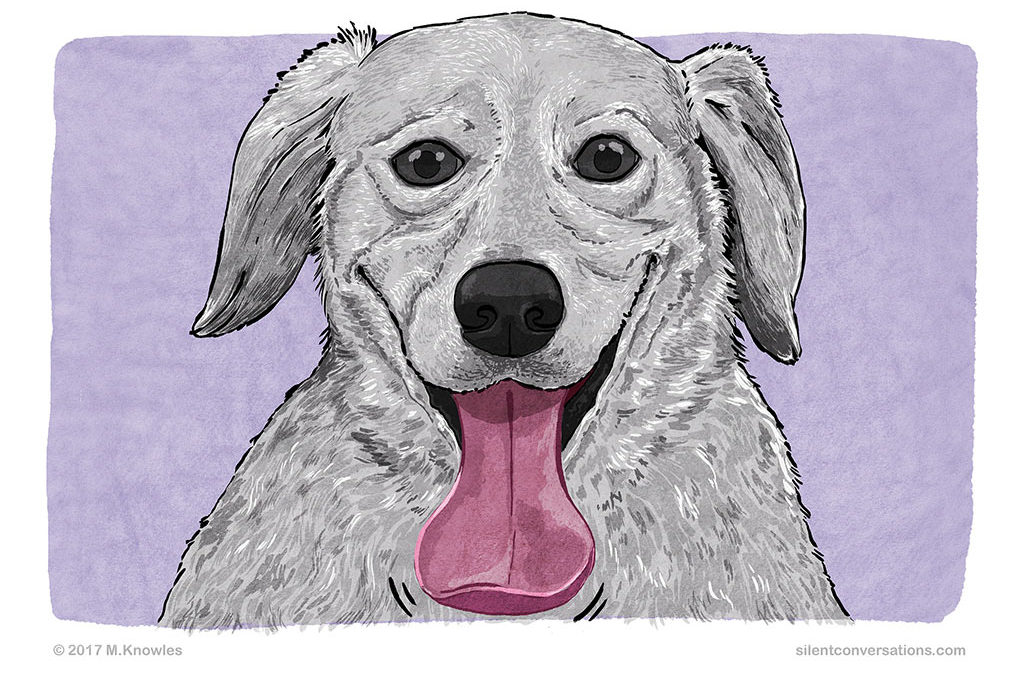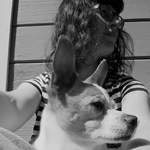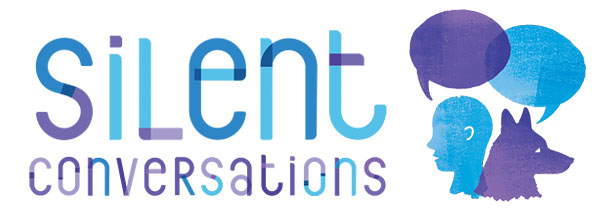
Spatulate tongue – Dog Body Language
Spatulate tongue – Dog Body Language
From a dog body language perspective, a spatulate tongue is indicative of a dog experiencing some form of stress*. This particular shaping of the tongue occurs when the dog has been panting, most likely due to stress*. The tongue becomes elongated and wider at the bottom and may curl up.
The widening and slight upward curl could be the result of muscular tension in the tongue. There is a distinct difference as to how the tongue appears after heavy panting due to exercise rather than stress. Instead of being held upwards, the tongue is likely to flop down when the panting is caused by exercise. This is a result of gravity rather than muscular effort.[1]
To elaborate, the following is the description of the spatulate tongue offered in ‘Canine Behavior – A Photo Illustrated Handbook’ :
“Spatulate tongue occurs particularly when a dog is stressed, but may also occur if the dog is hyperthermic/overheated and panting heavily to cool down his whole body. To determine the cause, note others signs of stress. In this dog [referring to a picture in the book, not shown here], tension ridges in his face as well as whale eye and forward flared whiskers suggest that this spatulate tongue portrays stress.”[2]
I was unsure if it is invariably the case that the tongue would be seen to flop down rather than curl up after heavy panting due to exercise. From my observations, in most cases the tongue does generally seem to flop down with panting relating to heavy exercise. However, I have seen exceptions where the tongue does curl upward. After further anecdotal observation, I noticed that there was a greater chance of the tongue curling up if the dog was panting at a rapid rate. It is worth considering that exercise could have an impact on stress* levels, depending on the individual dog and the amount or type of exercise. It is important to view each dog as an individual and find what is most appropriate for the individual to keep them in homeostasis.
With all observations relating to dog body language, it is important to take note of the context when offering an interpretation. As mentioned in the panting article, if a dog is panting out of context, as in he is not cooling himself or recovering from exercise, it is likely that the dog may be experiencing some form of stress. Additionally, if the dog is panting out of context, and a spatulate tongue is visible, this adds further evidence to substantiate the interpretation. Further observation of the whole body and body language of the dog should be noted. Brenda Aloff offers a good comparison of the body language shown by two different dogs where one is panting due to stress and the other due to exercise. The photo comparison can be found on page 36 of her book, ‘Canine Body Language – A photographic Guide.’
Brenda notes that in observing the silhouette of the stressed dog, the top line of the body looks rounded (roached), and the legs seem to be in a braced position. Brenda adds further observations of the dog’s body, noting facial tension and deep ridges around the eyes and lips. The eyes seem wide, with pupils dilated. The head and neck are lowered. The dog is panting with a spatulate tongue that is curled up tensely. The tail is not tucked but is held down against the body.
In comparison, the body of the dog that is panting due to exercise is in a neutral position; the back is held with its natural curves. There are visible ridges in the dog’s face under the eyes and around the dog’s mouth. This again shows the importance of context: dogs that may be showing tiredness due to activity may also show ridges in the face. The eyes are squinted and relaxed. The dog is panting with an extended tongue, with the bottom of the tongue hanging down. The tail is at body level and seems to be wagging.
If you have not already read the article about panting, read about it here. It is worth reading as it relates to the spatulate tongue.
Reference:
[1] Canine Body Language – A photographic Guide by Brenda Aloff: Page 36. For further reading, visit the resources section.
[2] Canine Behavior – A Photo Illustrated Handbook by Barbara Handelman, M.ED, CDBC: Page 244.
What is meant by stress*?
When I mention stress, this does not necessarily imply negative emotion. I mean stress in the physiological sense. So certain body language signals can mean the dog is feeling some sort of emotional discourse. This discourse could range from positive to negative emotion. Both excitement and fear could have similar effects on the body, with various hormones being released and activating the sympathetic nervous system. The dog may be feeling uncomfortable/fearful or it could also be excited about something. When analyzing stress in body language, it is worth noting the frequency and intensity of the various body language signals.
A few notes to consider when observing dog body language:
Observation before interpretation
Interpretations should be offered only once you have observed the complete interaction and taken note of the wider picture. To offer an unbiased interpretation of the body language, observe and take note of the situation, taking into account the dog’s whole body, the body language signals, and environment first before offering an interpretation. List all the body language you see in the order that it occurs; try to be as descriptive as possible without adding any emotional language. For instance, saying a dog looks happy is not descriptive and would be seen as an interpretation rather than an observation.
You could, however, list what you observe: ears to the side, eyes almond shaped, slight shortening of the eye, mouth open, long lips, tongue out, body moving loosely, body facing side-on, tail wagging at a slow even pace at body level.
From the observation, I could interpret that the dog seems relaxed or comfortable. I still prefer to say relaxed rather than happy, as I feel you will truly never know exactly what the dog may be feeling on the inside emotionally. It is quite likely the dog may be feeling happy, but I prefer to comment on how the dog is behaving in response to the situation rather than presuming internal emotional states.
The importance of viewing body language within context
Interpretations can vary depending on the context. It is possible for certain body language to be used in different contexts and have subtle differences in meaning within those contexts. Individual body language signals should not be observed in isolation; the wider picture should be considered. Take note of what the dog’s body as a whole is saying. Keep in mind each dog is an individual with varying skills and experiences. What may be typical for one individual may not be for another. In order to observe body language in context, consider the following: the situation, body language signals, the body language expressed by all parts of the dog’s body, environment, and individuals involved. It is worth noting how the body language changes with feedback from the environment or the other individuals interacting.

Martha Knowles
Author
My vision is to create a community of dog guardians who share their observations and interpretations of their dogs’ silent conversations. Hopefully, these experiences and stories will provide some insight into dog communication, which is often overlooked by the untrained eye because it is unfamiliar to humans. We are accustomed to communicating mainly with sound, so we are not attuned to the silent subtle gestures and body language used by dogs to communicate. If you take the time to observe, you will start to see these 'silent conversations' going on around you. My dream is for dog communication to become common knowledge with all dog guardians and as many people as possible. Surprisingly, there are still some professionals working in various dog-related careers who are uneducated about dog body language. Greater awareness of how dogs communicate will help to provide better understanding and improve the mutual relationship between dogs and humans. This will promote safer interactions between our two species and hopefully remove some of the expectations placed on dogs within human society. I would like dog guardians to feel empowered with their knowledge of dog communication so that they can be their dogs’ advocates and stand up for themselves and their dogs when it really matters.
